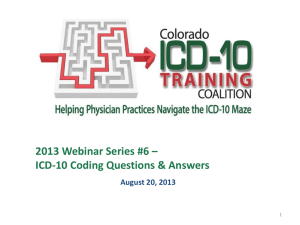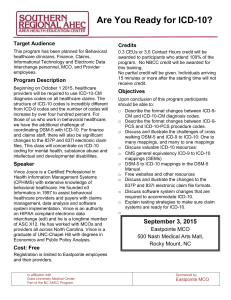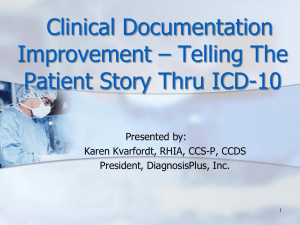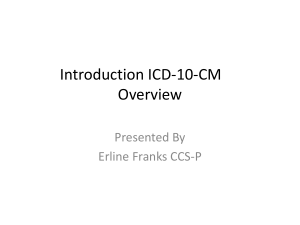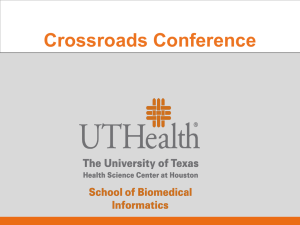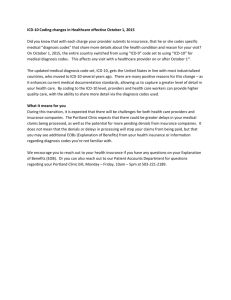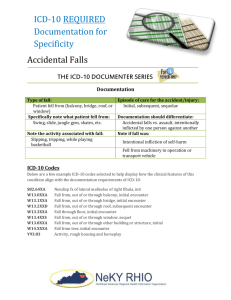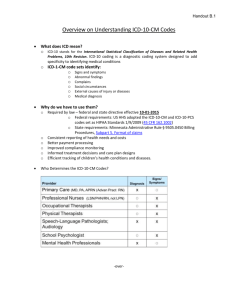Basic Introduction to ICD-10-CM/PCS
advertisement
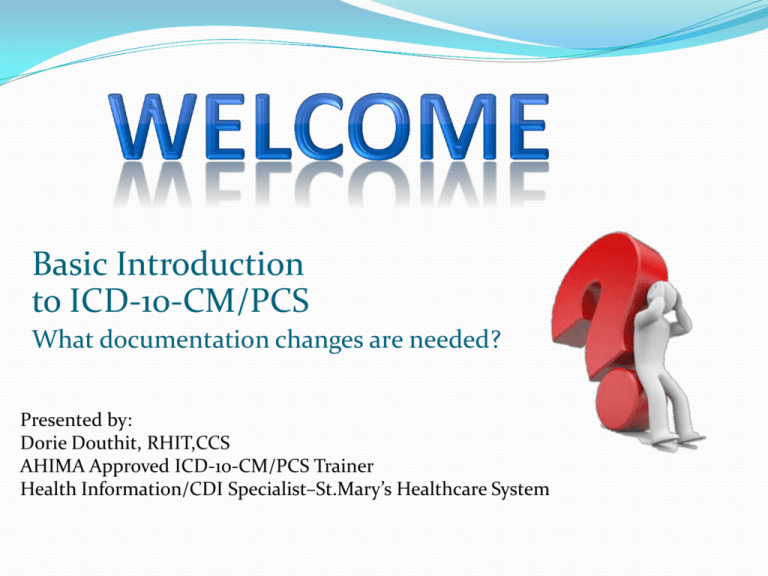
Basic Introduction to ICD-10-CM/PCS What documentation changes are needed? Presented by: Dorie Douthit, RHIT,CCS AHIMA Approved ICD-10-CM/PCS Trainer Health Information/CDI Specialist–St.Mary’s Healthcare System ICD-10 CM • Clinical Modifications, consist of approximately 68,000 diagnosis codes. ICD-10 PCS • ICD-10 PCS: Procedure Coding system, consists of approximately 87,000 codes. What does ICD-10 CM/PCS stands for? ICD-10-CM/PCS Facts: Effective 10/1/2014 ICD-10 -CM/PCS consists of two parts: ICD-10-CM for diagnosis coding in all health care settings ICD-10-PCS for inpatient procedure coding in hospital settings. CPT coding for outpatient and office procedures is not affected by the ICD-10 transition Numbers of Codes (2010) Diagnoses ICD-9-CM ICD-10-CM Procedures ICD-9-CM ICD-10-PCS 14,315 69,099 3,838 71,957 ICD-10-CM Structure ICD-9-CM 3 -5 characters First character is numeric or alpha (E or V) Characters 2-5 are numeric Always at least 3 characters Use of decimal after 3 characters ICD-10-CM 3 -7 characters Character 1 is alpha (all letters except U are used) Character 2 is numeric Characters 3 -7 are alpha or numeric Use of decimal after 3 characters Use of dummy placeholder “x” Alpha characters are not casesensitive Comparison: ICD-9 to ICD-10 434.11 Cerebral embolism with infarction Code represents embolism of cerebral arteries with infarction I63.40 Cerebral infarction dew to embolism of unspecified cerebral artery I63.49 Of other cerebral artery I63.411 Of right middle cerebral artery I63.412 Of left middle cerebral artery I63.419 Of unspecified middle cerebral artery I63.421 Of right anterior cerebral artery I63.422 Of left anterior cerebral artery I63.429 Of unspecified anterior cerebral artery I63.431 Of left posterior cerebral artery I63.432 Of right posterior cerebral artery I63. 439 Of unspecified posterior cerebral artery I63.441 Of right cerebellar artery I63.442 Of left cerebellar artery I63.449 Of unspecified cerebellar artery Why Change? ICD-10 provides more specific data than ICD-9 Better reflects current medical practices Updated medical terminology Improved clinical accuracy in the definition/classification of diseases More logically organized, more detailed and specific Structure accommodates addition of new codes ICD-9 is at capacity and cannot accommodate future coding demands in health care Expanded Data Capture for the reimbursement and data reporting ICD-10-CM: Similarities to ICD-9-CM Tabular List and Index Format • Chapters in Tabular structured similarly to ICD9-CM, with minor exceptions –A few chapters have been restructured –Sense organs (eye and ear) separated from Nervous System chapter and moved to their own chapters • Index structured the same as ICD-9-CM –Alphabetic Index of Diseases and Injuries –Alphabetic Index of External Causes –Table of Neoplasms –Table of Drugs and Chemicals ICD-10-CM: Similarities to ICD-9-CM Many conventions have same meaning –Abbreviations, punctuation, symbols, notes such as “code first” and “use additional code” Nonspecific codes (“unspecified” or “not otherwise specified”) are available to use when detailed documentation to support more specific code is not available ICD-10-CM: Similarities to ICD-9-CM ICD-10-CM Official Guidelines for Coding and Reporting accompany and complement ICD-10-CM conventions and instructions Adherence to the official coding guidelines in all healthcare settings is required under the Health Insurance Portability and Accountability Act ICD-10-CM: Differences from ICD-9-CM All codes are alphanumeric –1st character is always alpha and alpha characters may appear elsewhere in the code as well Codes can be up to 7 characters in length Codes are more specific Code titles are more complete (no need to refer back to a category, subcategory, or subclassification level to determine complete meaning of code) ICD-10-CM: Differences from ICD-9-CM Addition of 7th character Used in certain chapters to provide information about the characteristic of the encounter Must always be used in the 7th character position If a code has an applicable 7th character, the code must be reported with an appropriate 7th character value in order to be valid ICD-10-CM: Differences from ICD-9-CM Laterality (side of the body affected) has been added to relevant codes Expanded use of combination codes –Certain conditions and associated common symptoms or manifestations –Poisonings and associated external cause Injuries grouped by anatomical site rather than type of injury Codes reflect modern medicine and updated medical terminology New Features in ICD-10: Combination codes for conditions and common associated symptoms/manifestations I25.110 Atherosclerotic heart disease of native coronary artery with unstable angina pectoris E11.22 Type 2 DM with diabetic chronic kidney disease Combination Codes – Examples I25.110 Atherosclerotic heart disease of native coronary artery with unstable angina pectoris E11.311 Type 2 diabetes mellitus with unspecified diabetic retinopathy with macular edema K71.51 Toxic liver disease with chronic active hepatitis with ascites K50.012 Crohn’s disease of small intestine with intestinal obstruction N41.01 Acute prostatitis with hematuria New Features in ICD-10: Laterality (left, right, bilateral) L89.012 Pressure Ulcer of right elbow, stage II D27.0 Benign neoplasm of right ovary I63.412 Cerebral infarction due to embolism of left middle cerebral artery Laterality (Right/Left) Cancers Cerebral Infarction Pressure Ulcers Extremity Atherosclerosis Arthritis Fractures Sprains Injury Joint Pain Joint Effusion Tears, Meniscus, Cruciate Ligament Dislocations New Features: Combination codes for poisonings and associated causes T42.3x2S Poisoning by barbiturates, intentional self harm, sequela OB codes identify trimester instead of weeks or episode of care O26.02 Excessive weight gain in pregnancy, 2nd trimester Inclusion of clinical concepts not found in ICD-9 T45.526D Underdosing of antithrombotic drugs, subsequent encounter Y90.6 Blood alcohol level of 120-199 mg/100 ml ICD-10-CM: Excludes Notes Excludes1 note –Indicates that code identified in the note and code where the note appears cannot be reported together because the 2 conditions cannot occur together Example: E10 Type 1 Diabetes mellitus Excludes1: diabetes mellitus due to underlying condition (E08.-) drug or chemical induced diabetes mellitus (E09.-) gestational diabetes (O24.4-) hyperglycemia NOS (R73.9) neonatal diabetes mellitus (P70.2) type 2 diabetes mellitus (E11.-) ICD-10-CM: Excludes Notes Excludes1 note –Additional example: M21 Other acquired deformities of limbs Excludes1: acquired absence of limb (Z89.-) congenital absence of limbs (Q71-Q73) ICD-10-CM: Excludes Notes Excludes2 note –Indicates that condition identified in the note is not part of the condition represented by the code where the note appears, so both codes may be reported together if the patient has both conditions Example: L89 Pressure ulcer Excludes2: diabetic ulcers (E08.621, E08.622, E09.621, E09.622, E10.621, E10.622, E11.621, E11.622, E13.621, E13.622) non-pressure chronic ulcer of skin (L97.-) skin infections (L00-L08) varicose ulcer (I83.0, I83.2) ICD-10-CM: Excludes Notes Excludes2 note –Additional example: I70.2 Atherosclerosis of native arteries of the extremities Excludes2: atherosclerosis of bypass graft of extremities (I70.30I70.79) ICD-10-CM: Placeholder “X” Addition of dummy placeholder “X” is used in certain codes to: –Allow for future expansion –Fill out empty characters when a code contains fewer than 6 characters and a 7th character applies When placeholder character applies, it must be used in order for the code to be considered valid ICD-10-CM 7th Character Injuries – & External Causes A Initial encounter D Subsequent encounter S Sequela Note: For aftercare of an injury, assign acute injury code with 7th character “D” ICD-10-CM 7th Character – Fractures A Initial encounter for closed fracture B Initial encounter for open fracture D Subsequent encounter for fracture with routine healing G Subsequent encounter for fracture with delayed healing K Subsequent encounter for fracture with nonunion P Subsequent encounter for fracture with malunion S Sequela ICD-10-CM 7th Character Injuries – & External Causes A Initial encounter D Subsequent encounter S Sequela Note: For aftercare of an injury, assign acute injury code with 7th character “D” ICD-10-CM 7th Character – Fractures A Initial encounter for closed fracture B Initial encounter for open fracture D Subsequent encounter for fracture with routine healing G Subsequent encounter for fracture with delayed healing K Subsequent encounter for fracture with nonunion P Subsequent encounter for fracture with malunion S Sequela ICD-10 Improvements Updated medical terminology more consistent with the 21st century: More specific relative to anatomy and pathophysiology More adaptable to IT Increased specificity in clinical terminology also allows for improved medical necessity information and overall consistency and accuracy of data collection Improved data allows for more accurate: SOI and expected mortality reflections – profiling Reimbursement for services provided ICD-10 Implementation •Single implementation date for all users –Date of service for ambulatory and physician reporting –Date of discharge for inpatient settings •ICD-9-CM codes will not be accepted for services provided on or after October 1, 2013 •ICD-9-CM claims for services prior to implementation date will continue to flow through systems for a period of time •No grace period Physicians/Other Providers Only ICD-10cm---NOT ICD-10PCS -Any setting using CPT or HCPCSII would continue using these…not ICD-10PCS Revise Superbills/Encounter forms http://www.ahima.org/icd10 Coding Education - Billing - ABNs ICD-10 Implementation Considerations 1. Identify your current systems and work processes, either electronic or manual, in which you use ICD-9. 2. Talk to your current practice management system vendor. 3. Communicate with your clearinghouses, billing-service, as well as your payers. 4. Talk to your payers about possible changes to your contracts as a result of implementing ICD-10. 5. Identify potential changes to existing practice-workflow and business processes. 6. Identify staff training needs. 7. Test with your trading partners, e.g., payers and clearinghouses. 8. Budget for implementation costs, including expenses for system changes, business process changes, resource materials, and training. Vendor Assessment Check with vendor(s) on their readiness Will the update be part of the standard maintenance contract? (regulatory change) Renewing contracts -Price tags for updates -Timetable for testing Will there be any charges for interface changes or testing? Will vendor offer any education? 2 Most Important Takeaways for Physician offices Physicians will NOT have to use ICD-10 for any of their “procedure” coding. They will continue to use CPT When sending pts for OP Testing, use the narrative reason/symptoms for the test - PLEASE DO NOT USE THE ICD-10 CODE ON THE OP TESTING ORDER FORM Resources CMS Resources MS-DRG Conversion Report http://www.cms.hhs.gov/ICD10/Downloads/MsdrgConversion.pdf ICD-10 General Information http://www.cms.hhs.gov/ICD10 The following organizations offer providers and others ICD-10 resources AHIMA (American Health Information Management Association) http://www.ahima.org/icd10/default.aspx WEDI (Workgroup for Electronic Data Interchange) http://www.wedi.org HIMSS (Health Information and Management Systems Society) http://www.himss.org/icd10 Helpful Links http://www.cms.hhs.gov/ICD10 http://www.ahacentraloffice.org/ICD-10 http://www.ahima.org/icd10 http://www.aapc.com/ICD-10 http://www.cdc.gov/nchs/about/major/dvs/icd10des.h tm http://www.ahacentraloffice.org/ICD-10 Helpful Links cont’d 3M education modules for office managers and staff www.promisepoint.com/3m Login Email address: magicd10education@stmarysathens.org Password: St. Mary’s ICD-10CM Contact Information Tricia Davis, RHIA phone # 706-389-3365 Dorie Douthit, RHIT, CCS phone # 706-389-3364 Tammy Stewart, CCS phone # 706-389-3368 Questions? ICD-10CM Examples ASHD of Native Coronary Artery ICD.10.CM ICD.9.CM 414.01 125.10 Without angina pectoris 125.110 With unstable angina pectoris 125.111 With angina pectoris with documented spasm 125.118 With other form of angina pectoris 125.119 With unspecified angina pectoris Cerebrovascular Cerebral Infarction documentation will need to include: Due to thrombosis, embolism, occlusion, stenosis of specific artery: I63.131 Cerebral infarction due to embolism of right carotid artery I63.512 Cerebral infarction due to stenosis of left middle cerebral artery Intracerebral hemorrhage documentation will need to include: Location of the hemorrhage Subcortical hemisphere, brain stem, cerebellum, etc. Residual conditions due to CVA must be specified as: Left or right/dominant or non-dominant side - I69.351 Hemiplegia/hemiparesis following cerebral infarction affecting right dominant side. Cardiovascular CAD (coronary arteriosclerosis) is specified as of native vessel, bypass graft, or transplanted heart. Combination codes to include CAD with angina (unstable, with spasm, other) as well as CAD with ischemic chest pain. Myocardial infarction can be specified as current (within the last 4 weeks), diagnosed on EKG but with no presenting symptoms, healed/old; intraoperative, post-operative, or recurrent. If current, further specification by site (anterior, STEMI, Q wave, etc) is necessary. Examples for cardiovascular Physician office documentation: “reports history of CAD, HTN and angioplasty.” Need specification if the CAD is still present after angioplasty, and if so, is it of a native artery (I25.10) or of the bypass (I25.810). Inpatient physician documentation: “patient has history of ESRD, CHF and high blood pressure”. There is conflicting documentation on this chart from another physician stating that the patient has HTN. HBP and HTN are coded differently, and if the patient truly has HTN (I10) it should be documented as such, not as HBP (R03.0). Laterality For all body parts that can be defined as left, right or bilateral side(s), the specific “side” must be documented. Examples: Hemiplegia/hemiparesis Pressure Ulcers Phlebitis or Thrombophlebitis Varicose Veins Postphlebitic syndrome DVT lower extremities - Must also specify specific vein (femoral, iliac) Examples of laterality Physician office documentation “patient complains of hearing loss (right); large right cerumen impaction” – good example of laterality documentation (H61.21 – impacted cerumen, right ear) Physician office documentation “patient presents with glaucoma and senile cataract” – This would need specification for the glaucoma and cataract(s), are they right, left, or bilateral? Fractures: More information will be required to accurately code fractures in ICD-10 type of fracture specific anatomical site whether the fracture is displaced or not laterality routine versus delayed healing nonunions and malunions Fractures: Seventh character extensions are assigned for fractures to indicate: fracture is the initial or subsequent encounter or sequelae/late effect the type of fracture (open or closed) the type of healing (routine, delayed, malunion or nonunion Example: S52.521D: Torus fracture of lower end of right radius, subsequent encounter for closed fracture with routine healing. (see graphic above) Open Fractures: Some fracture categories provide for seventh character extensions to designate the specific type of open fracture (based on the Gustilo open fracture classification) The classification is as follows: I II IIIA IIIB IIIC Low energy, wound less than 1 cm Wound greater than 1 cm with moderate soft tissue damage High energy wound greater than 1 cm with extensive soft tissue damage Adequate soft tissue cover Inadequate soft tissue cover Associated with arterial injury Example: S82.111N Displaced fracture of right tibial spine, subsequent encounter for open fracture type IIIA, IIIB, or IIIC with nonunion Other Musculoskeletal Diagnoses Osteoarthritis now divided into Primary, Secondary, Post-Traumatic, Generalized, etc More specific categories for rheumatoid disease of organs with rheumatoid arthritis: lung, vasculitis, heart disease, myopathy, polyneuropathy, bursitis, nodule, etc. Documentation of pathological fractures will require the underlying cause of the fracture. Skin Disorders Cellulitis (skin infection) and abscess (collection of pus) are now in separate categories, and the terms should not be used interchangeably. Codes for furuncle (painful boil caused by infection of hair follicle) and carbuncle (group of boils that have clustered together) are now separate categories with specific sites and lateralities. Terms should not be used interchangeably. Contact dermatitis should now be specified if it is allergic, irritant, or other with the cause specified. (makeup, plant, detergent, etc) Urosepsis: “Urosepsis” is not a term that can be coded in I-10. This will guarantee a query! Specify if the patient has a UTI, SIRS due to a UTI, or Sepsis Indwelling catheter or –ostomy: The link between the UTI and catheter/device must be documented E. Coli UTI: ICD-9 : 599.0 041.4 ICD-10: N390 B962 Other Genitourinary disorders Cystitis – with or without hematuria Urethral stricture – post-infection or post-traumatic Prostatitis – acute or chronic, with or without hematuria Erectile dysfunction – needs underlying cause Fistula of female genital tract – specific as to site Excessive/frequent menstruation – with or without regular cycle Chronic renal failure after a kidney transplant needs to be documented as a complication or expected result Anemia Anemia with Neoplasm – specify how it’s related Associated with/due to the malignancy Associated with chemotherapy Associated with immunotherapy Associated with radiation therapy Anemia with underlying cause needs to be specified Nutritional anemias: specify cause - inadequate dietary intake, malabsorption, adverse effect of medication Other anemias – just like with ICD-9, we continue to need documentation of acute vs chronic blood loss, as well as anemias due to other chronic diseases. Pregnancy/Obstetrics All diagnoses related to a patient’s pregnancy should have the trimester in which the problem began documented. (1st trimester up to 13 weeks, 6 days; 2nd trimester 14 weeks 0 days to 27 weeks 6 days; 3rd trimester 28 weeks 0 days to delivery) Example: O132, Gestational (pregnancy-induced) hypertension without significant proteinuria, second trimester Expanded codes for more specific codes while pregnant (malnutrition, excessive/low weight gain, abnormal test findings on screenings, etc) Tobacco Use/Exposure Tobacco use/abuse codes now specify what type of tobacco (cigarettes, chewing tobacco, etc). Also specific codes for types of second hand tobacco smoke (from parent, at work, perinatal, etc) Any patient with a respiratory diagnosis and/or cardiac diagnosis, should have documentation of current and/or past tobacco smoke exposure/abuse. Example: Tobacco Use Physician office documentation – “Former smoker, 25- 50 pack years”. This is an example of good documentation and would be coded as ICD-10 F172.10 Physician office documentation – “current tobacco use”. This example of documentation would need more clarification. Is patient tobacco dependent? Does patient smoke cigarettes (F172.10), cigars/other (F172.90), or use chewing tobacco (F172.20)? Asthma/Bronchitis/COPD Needs to be documented as mild, moderate or severe. Mild asthma must be documented as intermittent or persistent. Acute bronchitis – now has a combination code to show the organism responsible for the bronchitis. COPD – should be specified as to type (emphysema, chronic bronchitis/asthma, acute exacerbation, decompensated, due to organic dust, allergic, etc) Personal and Family Histories Expanded number codes for personal and family history of diseases. Personal history Allergies, diseases/disorders, drug/alcohol dependence, malignancies, MI, non-compliance, surgeries, etc Family history Drug/alcohol abuse, arthritis, blindness, genetic disorders, chronic diseases, diabetes, malignancies, mental disorders, respiratory conditions, stroke, etc Examples of Histories Physician office documentation “personal history of chickenpox, mumps, tonsillectomy, lap band, tubal ligation, family history of diabetes, former tobacco use” “personal history of appendectomy, has never used tobacco, family history of CAD and stroke (father at 83 years old) These are examples of good documentation of a patient’s history. “Past, family and social history” left blank, or “denies” This would need more clarification. If the patient truly denies all histories, or refuses to give information, the documentation should state “patient refuses” or “patient denies history of any surgeries or medical problems, no significant family history”. Other diagnosis examples Physician office documentation: “Impression: Severe aortic stenosis, chronic diastolic CHF, iron deficiency anemia, DM, status post CVA with left-sided hemiparesis, lymphedema, DJD” On the encounter form for this patient, it states “anemia 285.9, AS 747.22, edema 782.3, DM 250.00” (written by physician) The diagnoses in the patient’s notes differ from the codes/diagnoses listed on the encounter form. According to what is documented on the record, the diagnoses/codes should be: severe aortic stenosis 424.1, chronic diastolic CHF 428.32 + 428.0, iron deficiency anemia 280.9, DM 250.00, status post CVA with left-sided hemiparesis 438.22, lymphedema 457.1, DJD 715.90. This issue will be even more important with ICD-10 as there are so many more codes to choose from. ICD-10 codes for this patient: AS I35.0, CHF I50.32, fe def anemia D50.9, DM E11.9, s/p CVA with hemiparesis I693.54, lymphedema I89.0, DJD M19.90 – however, most of these codes are “unspecified”. In ICD-10, there are specific codes for the type/cause of most of these disorders. For example, for lymphedema, choices are hereditary, post-mastectomy, secondary, surgical, glandular, streptococcal, lymphangiectatic, congenital, etc. Type of diabetes Diabetes Due to underlying condition Due to drug/chemical Type I Type II Other Manifestations are more specific, with more combination codes No longer classified as controlled or uncontrolled Inadequately, out of control or poorly controlled are coded by type (I or II) with hyperglycemia
